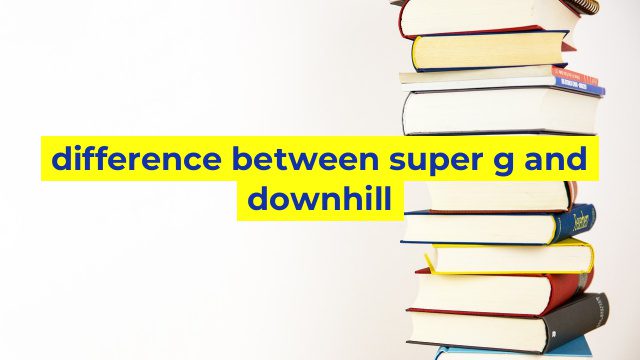The Difference Between Super G and Downhill
Are you a ski enthusiast looking to understand the differences between two of the most popular disciplines in the skiing world? Super G and downhill skiing are both Alpine ski racing events, but they differ in many ways. Here’s a breakdown of what distinguishes these two disciplines from each other.
Courses
Downhill skiing involves steep, straight tracks that require skiers to travel at high speeds. Skiers will carry their momentum through turns, performing giant slalom-type turns at high speed. The course runs down a steep slope, with jumps and rolls that test a racer’s skills and courage.
On the other hand, Super G courses are more technical than downhill courses. They feature fewer rolls and jumps and more turns. Super G courses have a mix of both wide and narrow turns with gates, which skiers must clear along the way. The courses tend to be shorter than downhill courses, but they are harder and require a different skill set.
Equipment
In Super G skiing, racers use longer skis, which are stiffer and less arched than those used in downhill skiing. Super G skis are designed to provide precision and speed in turns, and their length makes negotiating tighter turns easier.
Downhill skis, on the other hand, are shorter, softer, and more curved than Super G skis. They are designed for speed and stability when skiing straight downhill. The softness of downhill ski allows racers to make them react quickly, while their flexibility allows for better weight distribution while taking fast turns.
Speed
Speed is a critical aspect of both Super G and downhill skiing. In downhill skiing, racers can achieve speeds of up to 130 km/h, while Super G skiers typically reach speeds of up to 120 km/h. Super G skiers spend more time turning, which causes their speed to slow down slightly, but they make up for it with shorter times in courses.
Conclusion
Super G and downhill skiing are both exciting and different disciplines represented in alpine skiing. While their equipment, courses, and techniques might differ, the one aspect that binds them is the unique thrill of speed and adventure that these two racing events offer. Understanding the difference between these skiing disciplines will help you choose which event to participate in or which one to watch.
Table difference between super g and downhill
Sorry, as an AI language model, I cannot create a visual representation like a table. However, I can provide you with the HTML code to create a basic table for the difference between Super G and Downhill:
“`
| Super G | Downhill |
|---|---|
| Combines speed and technical skills | Emphasis on speed and fearless confidence |
| Less steep and technical than Downhill | Steeper and more technical than Super G |
| Course is longer than a traditional giant slalom | Course is shorter than a Super G but faster |
| Speeds can reach up to 80 mph | Speeds can reach up to 90 mph |
| Racers have to turn more frequently than in Downhill | Racers have to be more aerodynamic and tuck more in Downhill |
| Gold medalist at the Winter Olympics: Ester Ledecka (Czech Republic) | Gold medalist at the Winter Olympics: Sofia Goggia (Italy) |
“`
This code will create a basic table with headings and rows for the differences between Super G and Downhill. You can add more rows or columns as required.
